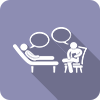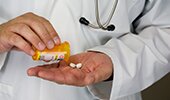- Can Tramadol Abuse and Addiction Be Treated?
- Do I Need Addiction Treatment?
- Types of Treatment
- Dual Diagnosis Treatment: What to Expect
- How to Choose the Best Treatment for Tramadol Addiction
What Is Tramadol Addiction?
Tramadol (Ultram, Ultracet) is prescribed for the treatment of moderate to severe pain. Tramadol’s
risk for addiction has been assessed in multiple populations.
In July 2014 The Drug Enforcement Administration (DEA) scheduled tramadol as a Schedule IV opioid analgesic, thereby implying its high abuse potential.
Can Tramadol Abuse and Addiction Be Treated?
Addiction affects not only the individual but the family and the community’s health and safety.
In 2002, the National Institute on Drug Abuse (NIDA) defined addiction as a chronic relapsing disease characterized by compulsive drug-seeking and abuse, and by long-lasting chemical changes in the brain.
It involves environmental and psychosocial underpinnings which influence its development and progress in the addicted individual. Addiction affects not only the individual but the family and the community’s health and safety as well.
Therapists are Standing By to Treat Your Depression, Anxiety or Other Mental Health Needs
Explore Your Options Today
Ad
According to the American Society of Addiction Medicine (ASAM), recovery from addiction is best achieved through a combination of:
- Self-management.
- Mutual support.
- Professional care provided by trained and certified professionals.
Recovery is a process, not an event! Like any chronic illness, recovery from tramadol addiction is a journey involving treatment and lifestyle changes, requiring the attention of licensed, certified professionals.
Treatments which are known to work are family therapy; many who struggle with narcotic abuse or painkiller dependency are parents to underage children who are at a high risk of developmental and behavioral problems – which sometimes continue through adolescence.
- Family therapy aims to limit the detrimental consequences of addiction on family members, while trying to remedy strained relationships so that the overall family dynamic can be one of support, mutual understanding and respect for everyone involved.
Cognitive Behavioral Treatment (CBT) is a psychological therapy with widely-demonstrated effectiveness for treatment of opioid addicts who also present with co-occurring behavioral and/or mental health conditions, such as post-traumatic stress disorder (PTSD) – a common co-occurring disorder in opioid addicts.
The DEA has found that
tramadol is most commonly abused by narcotic addicts, chronic pain patients, and health professionals.
Effective treatment will be tailored to the specific needs of these populations.
Do I Need Addiction Treatment?
The Diagnostic and Statistical Manual of Mental Disorders, Fifth Edition (DSM-V) (2013), uses a number of criteria for addiction with tramadol. If you are not sure if you have a problem with tramadol use, check out these symptoms:
 You don't deserve to suffer the effects of tramadol addiction. Find a treatment center and begin your path to recovery today.
You don't deserve to suffer the effects of tramadol addiction. Find a treatment center and begin your path to recovery today.
- Persistent desire to cut down or regulate the use of tramadol without success.
- Spending lots of time obtaining tramadol (with neglect of friends or social activities that were formerly cherished and enjoyed)
- Daily activities revolve around the drug (family and work may be neglected).
- Tolerance – the need for more of the drug in order to achieve the same effect.
- Withdrawal sickness – with symptoms like anxiety, cramps, nausea, and diarrhea.
- Failure to abstain from use despite the knowledge of harmful effects.
While the degree to which the addiction develops will vary with the amount of the drug used, the extent of abuse and route of administration; studies have shown a pattern of problems specific to tramadol:
- At 300 mg, tramadol has a moderate opioid action, but at doses over 700 mg tramadol can produce seizures. This may be caused by the interaction of opioid effects with the serotonin-norepinephrine reuptake inhibition effect of tramadol, and/or its high potential for serotonin syndrome when taken with medication such as fluoxetine or sertraline (Prozac or Zoloft).
- Symptoms of serotonin syndrome include altered mental state, jerky movements in the extremities, general weakness, and nausea. It requires immediate treatment.
Types of Treatment

Residential Rehab
These include long-term therapeutic communities (TCs), with a timeframe of eighteen to twenty-four months. Funding restrictions have demanded alternatives to such lengthy stays, replacing them with 28 or 30, 60, or 90-day programs. In residential treatment, patients are frequently responsible for daily activities, such as keeping the residence clean, and maintaining house rules. The advantage of residential programs is that they offer a safe place to deal with addiction and recovery away from an enabling environment where drugs such as tramadol are easily available.
Additionally, the individuals learn to live with others and resolve interpersonal problems appropriately, thereby preventing avoidance of conflict or emotions.
Phases of residential treatment typically include:
- Stabilization.
- Detox / early recovery.
- Maintenance of recovery.
- Relapse prevention education.
- Aftercare planning.
Inpatient vs.Outpatient Care
Inpatient care is essential for those who pose a risk to themselves or to others – as long as these issues are present. Additional medical or psychiatric issues can also be addressed in an inpatient setting. Frequently, on-site medical care is a component of inpatient or residential treatment. Inpatient care facilitates comprehensive medical and psychiatric evaluations, detox, and management of unpleasant withdrawal symptoms.
Outpatient care is appropriate for patients with less severe dependencies, and/or whose co-occurring conditions are stable. Individuals who are committed to recovery, and engaged with addiction interventions such as counseling and medical interventions, are suitable for outpatient care.
Luxury programs, and private treatment centers include a broader range of services. Holistic approaches to rehabilitation are sometimes offered as a component of this level of treatment. Additional services may include yoga, art therapy, meditation, nutritional and fitness programs. Patients with chronic pain who are addicted to tramadol may benefit from programs which include lifestyle changes and alternative methods of pain management. Physical exercise is reported to be one of the best treatments for chronic pain, starting with a physical therapy assessment and an appropriate exercise program.

Executive Programs
These programs are appropriate for high profile clientele, business executive types or health professionals – the latter being a population which the DEA has found to be particularly vulnerable to tramadol addiction.
As a minor opioid, tramadol is often used by primary care practitioners or OB/GYN specialists. Physicians have complex treatment needs and executive treatment programs (often the destination of health care diversion programs) provide highly-specialized services tailored to such needs.
Medically assisted treatment for tramadol addiction will be similar to pharmacotherapies for other opioids, using antagonists such as naloxone or naltrexone, and symptom-management pharmaceuticals such as clonidine. Methadone and buprenorphine also have a high efficacy with this population, especially with diminishing craving.

Counseling and Therapy
Cognitive behavioral therapy (CBT) has become one of the most scientifically-proven treatments for drug addiction. Its central tenet is that a person can learn to recognize and surrender self-defeating thoughts, emotions and behaviors which trigger the use of drugs. New behaviors are subsequently learned that reinforce sobriety.
Well-supported in scientific research, motivational enhancement therapy (MET) begins with the assumption that the client’s own internal motivation is the driving force in treatment. The role of a counselor is that of supporting and helping the client’s motivation.
Contingency management (CM) involves the positive reinforcement of reward to increase abstinence from tramadol. Clients are rewarded with vouchers which are exchangeable for items contingent upon recently verified abstinence from opioids.

Partial Hospitalization and Intensive Outpatient Treatment
Partial hospitalization resembles inpatient treatment but is not 24 hours per day, and may provide limited medical and nursing care, such as regular medical examinations. Patients may attend treatment for 5, 6, or 7 days per week, but return home in the evening.
Intensive outpatient treatment (IOP) is able to treat addiction issues alone, or in conjunction with co-occurring mental/physical disorders – providing treatment for a fixed number of hours per week which includes individual, group, and/or family therapy in addition to psychosocial education. These treatments have been demonstrated to be as effective as inpatient treatment for most individuals seeking care.
Dual Diagnosis Treatment: What to Expect
Dual diagnosis/co-occurring mental disorder involves integrating the concept that many individuals who present for drug treatment are likely to have co-occurring disorders and needs.
This mode of treatment expands the range of issues in a recovery-oriented framework to help all service providers address the multidimensional needs of the addicted person.
Such addiction programs generally have diverse populations in which some of the clients will have no co-occurring disorders, and whose treatment will focus on addiction only. The majority, however, will range from affective disorders such as major depression and generalized anxiety to cognitive deficits and/or history trauma.
Research indicates that the effectiveness of these programs is bolstered by a strengthening of the clinician/client relationship because of the special attention which patients receive.
As many as 50-75% of individuals presenting with addiction also have another diagnosable
mental health disorder. If you are addicted to tramadol and are worried about any co-occuring illnesses, do not wait to find help.
Call now at
1-888-993-3112Who Answers? and a treatment support specialist will listen to you, answer any questions, and help you find the kind of program for your recovery and good health. Your journey has begun with this step.
How to Choose the Best Treatment for Tramadol Addiction
There are many considerations that should go into choosing treatment. Make sure to:
- Ensure that the facility accepts your insurance, and see what is covered/not covered. What are their billing practices for co-occurring disorders? Are both covered?
- Check their treatment outcomes and success rates.
- The most effective rehabs will treat co-occurring disorders, providing access to treatment for depression, anxiety, and bipolar illness.
- Meet the staff.
- Get a ‘feel’ for the spirit of a place, and check out their mission statement which defines what they are about.
- Are they inclusive of everyone?
- Find out if it is disability-accessible. Don’t forget to check out the bathrooms!
- Inquire if the rehab provides access to quality therapies and medical treatments, if you suffer from chronic pain.
- Ask whether family therapy is integrated. Your family and significant others are part of your recovery.
- Ensure that the treatment is evidence-based, and grounded in research on addiction treatment.
Remember, recovery is a process. Ask the following questions:
- Does the facility arrange for structured aftercare programs?
- What type of follow up is provided?
- Do they provide transportation if needed?
- Does the treatment center help locate peer recovery support in your community?
- How welcoming is the facility to your spiritual/religious minister, Rabbi, or local Imam?
Call to speak with a treatment placement professional today at
1-888-993-3112Who Answers? who can listen and help you find a treatment plan tailored to your particular needs.
- American Psychiatric Association, 2013. Diagnostic and Statistical Manul of Mental Disorders. 5th Edition. Washington, DC: Author.
- Brook, J.S., et al., 2008. Chapter 3: Epidemiology of Addiction. In Gallanter, M., and Kleber, H.D., eds. The American Psychiatric Publishing Textbook of Substance Abuse Treatment. Fourth Edition. Washington, DC: American Psychiatric Publishing, Inc.
- Butler, M., et al., 2008. Integration of Mental Health/Substance Abuse and Primary Care. Evid Rep Technol Assess 173:1-362.
- Darnall, B., 2015. Treating Chronic Pain Without Opioids. Providers’ Clinical Support System (PCSS). www.PCSS-O.org.
- Earley, P.H., 2009. Chapter 40: Physician Health Programs and Addiction among Physicians. In Ries, et al., eds. Principles of Addiction Medicine.Fourth Edition. Philadelphia, PA: Lippincott, Williams & Wilkins.
- Hazelden and NAADAC, 2010. IntegratingTreatment for Co-occurring Disorders: An Introduction to What Every Addiction Counselor Needs to Know. Alexandria, VA: NAADAC Knowledge Center.
- Higgins, S.T., and Silverman, K. 2008. Contingency Management. In Ries et al. (previously cited).
- Landry, M.J. 1994. Understanding Drugs of Abuse: The Processes of Addiction, Treatment, and Recovery. Washington, DC: American Psychiatric Press, Inc.
- Hser, Y-I, and Anglin, M.D., 2005. Chapter 20: Drug Treatment and Aftercare Programs. In Coombs, R.H. ed. Addiction Counseling Review: Preparing for Comprehensive, Certification, and Licensing Examinations. Mahwah, NJ: Lawrence Erlbaum Associates.
- McCarty, D., et al. 2014. Substance Abuse Intensive Outpatient Programs: Assessing the Evidence. Psychiatr Serv 65(6):718-726.
- Mee-Lee, D, et al., eds.,2013. The ASAM Criteria: Treatment Criteria for Addictive, Substance-Related, and Co-Occurring Conditions. Third Edition. Chevy Chase, MD: American Society of Addiction Medicine, Inc.
- Pihkala, H, and Sandlund, M. 2015. Parenthood and Opioid Dependence. Subst Abuse Rehab 6:33-40.
- SAMHSA, 2006. Substance Abuse: Clinical Issues in Intensive Outpatient Treatment. TIP 47. Rockville, MD: USDHHR.
- Stine, S.M., and Kosten, T.R., 2009. Pharmacologic Interventions for Opioid Dependence. In Ries, et al. (previously cited)
- Storie, M., and Kuehn, D., eds., 2005. Basics of Addictions Counseling: Desk Reference and Study Guide. Alexandria, VA: NAADAC.
- Shakoor, M.T., et al., 2014. Transiet Serotonin Syndrome Caused by Concurrent Use of Tramadol and Selective Serotonin Reuptake Inhibitor. Am J Case Rep. 15:562-564.
- Tetrault, J.M., and O’Connor, P.G., 2009. Management of Opioid Intoxication and Withdrawal. In Ries, et al. (previously cited).
As advocates of mental health and wellness, we take great pride in educating our readers on the various online therapy providers available. MentalHelp has partnered with several thought leaders in the mental health and wellness space, so we can help you make informed decisions on your wellness journey. MentalHelp may receive marketing compensation from these companies should you choose to use their services.
MentalHelp may receive marketing compensation from the above-listed companies should you choose to use their services.
Ad





